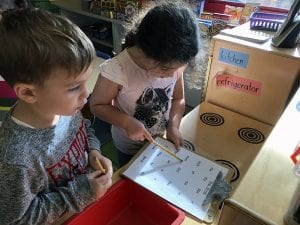Kindergartners in Amy Sheehy and Anna Coughlin’s classes at William O. Schaefer Elementary School have phonics fever, thanks to new Teachers College Reading & Writing Project phonics units introduced this year. The units being piloted in three WOS kindergarten classrooms are aligned with the Next Generation ELA Standards, as well as the Teachers College reading and writing units.
“The engagement is so high. There are lots of activities and opportunities for movement,” said Mrs. Sheehy. “But the biggest piece is that students are transferring their phonics skills much more quickly to their reading and writing.”
Both classes are working on “snap words,” also known as sight words, such as “at,” “like,” “I,” “the” and “here.” On Thursday morning, Mrs. Sheehy’s students raced around the room on a scavenger hunt, looking for snap words that look differently from how students might write them because of the font used in texts. “How can you tell that a (sans serif) ‘I’ is a (serifed) ‘I’ and not an ‘L’ or a ‘1’?” she asked. “Because we’ve had a chance to practice looking for our snap words.”
Meanwhile, Ms. Coughlin’s students practiced spelling and saying snap words by using a variety of voices (mouse voice, fancy voice, work voice, silly voice) before splitting into pairs for a game of snap word “I Spy.” “The TCRWP Phonics units are based on a workshop model,” explained Ms. Coughlin. “We start with a mini-lesson on the rug, then split into groups for students to explore and try on their own. Then, we come back together to reflect.”
Both Mrs. Sheehy and Ms. Coughlin have seen a difference in terms of both the instructional approach and the results. “The old program was very much focused on direct instruction and drill and repeat,” said Ms. Coughlin. “With TCRWP, there’s a ‘why’ behind every lesson, so students understand the big picture of why phonics are important to learn. And, the structure allows teachers to differentiate much more easily. Students who are still learning all the snap words might use simpler clues, such as ‘I spy a word with three letters.’ Those who have already know the snap words can shift to higher-level thinking and use a clue like ‘I spy a word with a silent ‘e’ at the end.’”
The teachers piloting the TCRWP program attended a three-day training at Teachers College last summer. “It heightened our awareness about the importance of transfer,” Mrs. Sheehy noted. “Transfer isn’t automatic for all kids, so this is something we really need to focus on. They’re more engaged, they’re excited and they’re using what they know about phonics much more readily.”
Assistant Principal Maggie White echoed teachers’ observations. “I have seen such a high level of engagement in these classrooms. Students are having really sophisticated conversations about words and phonics.”
Tommy C., one of Ms. Coughlin’s students, sums it up: “Sight words help you write and read.”


You must be logged in to post a comment.